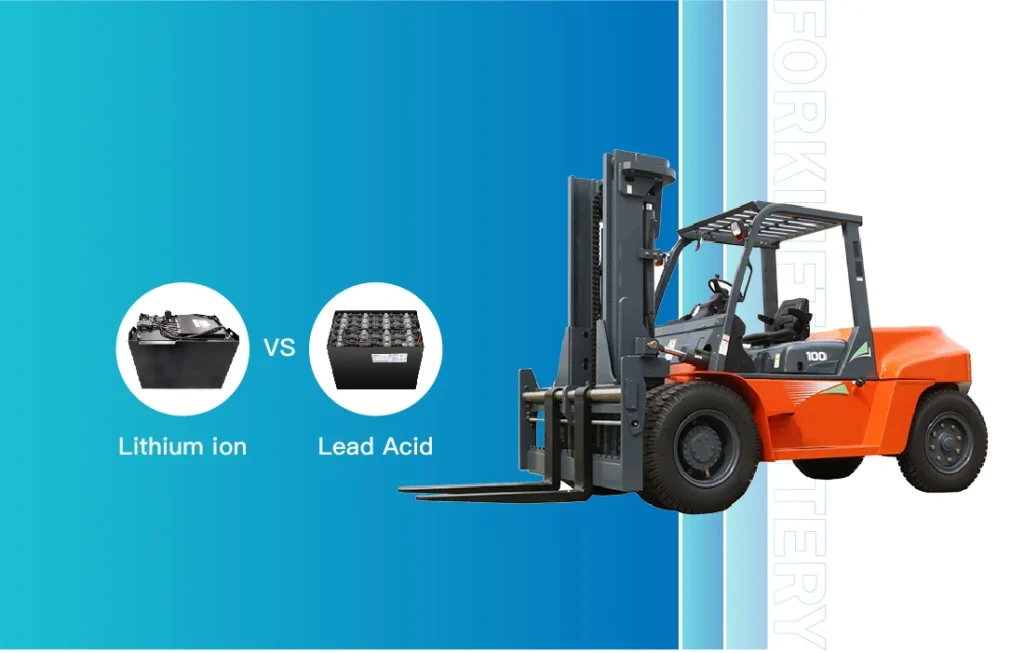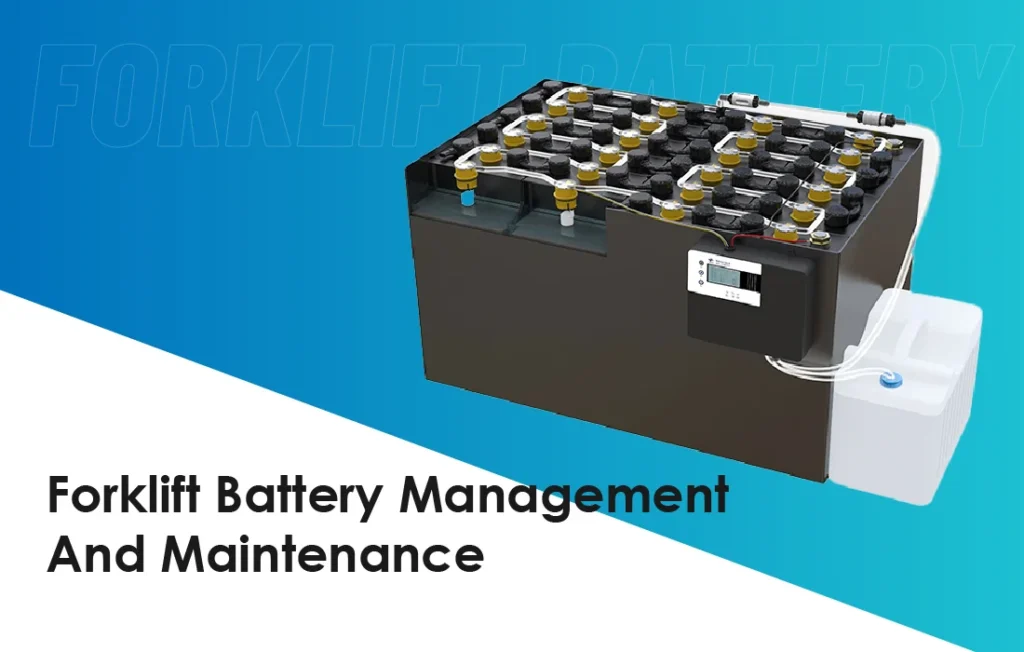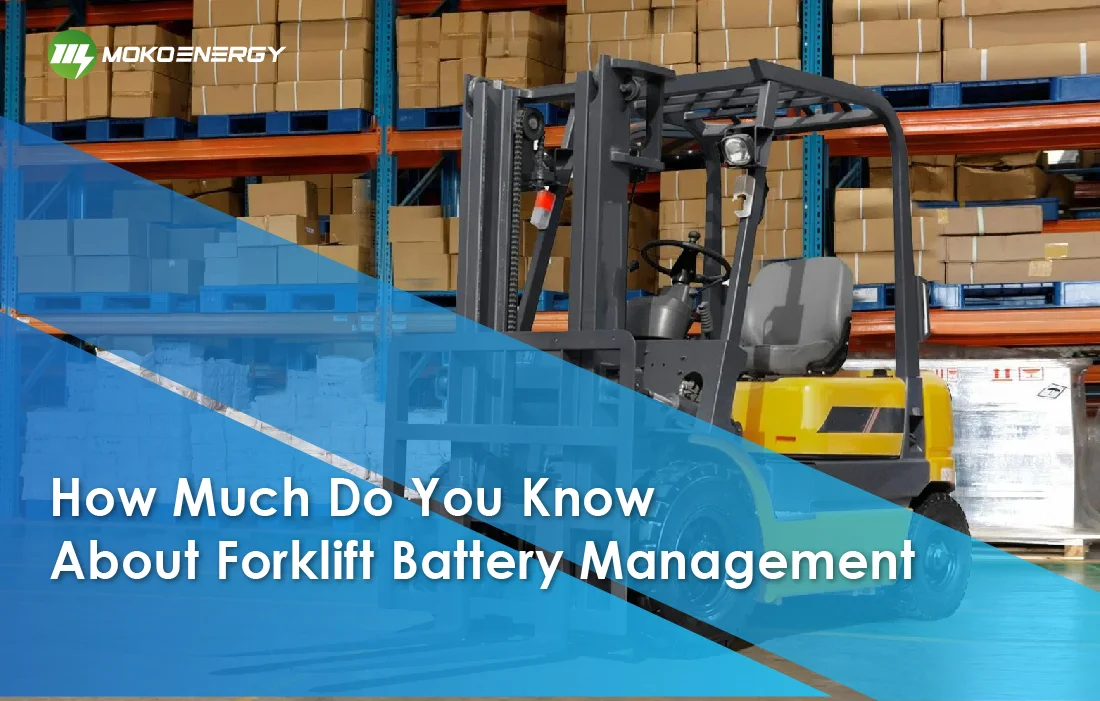From the cost perspective, electric forklifts are more advantageous than fuel forklifts, and thus the use of electric forklifts in the logistics and production sector is steadily increasing. The maintenance of the forklift battery determines its service life. A properly maintained battery can last over five and half years while a poorly maintained battery will only last for one to two years and require replacement. Furthermore, considering that a forklift battery is costly, the difference in the battery durability resulting from maintenance will significantly determine the cost of an electric forklift. Proper forklift battery management is crucial for maximizing productivity, reducing downtime, and ensuring a safe working environment.
What Type of Battery Does an Electric Forklift Commonly Use?
Lead-acid batteries used in electric forklifts are known to provide reliable and fairly inexpensive power sources. The other commonly used battery type is the lithium battery. These two types of batteries also have their own characteristics and should be used in different working environments and situations.

1. Lead-acid batteries
Advantages | -Cost-Effective: Initially cheaper than lithium-ion batteries. -Availability: Widely available and easily replaceable. |
Disadvantages | -Maintenance-Intensive: Requires regular watering and equalization. -Long Charging Time: Typically takes 8 hours to charge and an additional 8 hours to cool. -Weight: Heavier than lithium-ion batteries, affecting forklift handling. |
The lead-acid battery is one of the most conventional and frequently applied battery types in electric forklifts. It contains lead plates and sulfuric acid electrolytes. Its energy density is lower, and it is relatively cheaper. Flood lead-acid battery and SLA are two commonly used lead-acid battery types. Between them, the flood lead-acid battery is used more commonly. The advantages of lead-acid batteries are reliability, long cycle life, and low costs. It can be fast charged and discharged cycle times. However, there are several areas of concern when it comes to lead-acid batteries as outlined below. Large weight – one of the biggest concerns with lead-acid batteries since they increase the overall weight of electric forklifts and their range. Long charging time and fast self-discharge are also its shortness. Lead-acid batteries are also more challenging to maintain frequently, as they need water topping-up and equalization charging.
2. Lithium-ion Batteries
| Advantages | -Fast Charging: Can be fully charged within 1-2 hours. -Longer Lifespan: Lasts up to 3-4 times longer than lead-acid batteries. -Low Maintenance: No need for regular watering or equalization. |
| Disadvantages | -Higher Initial Cost: More expensive upfront compared to lead-acid batteries. -Specialized Handling: Requires specific charging equipment and handling procedures. |
Lithium batteries are now coming into the market and exhibiting as an emerging battery technology in the electric forklift sector. They have a high energy density. They pointed out that the advantages include light weight and long use time compared with lead-acid batteries. Lithium batteries also consume less energy have no memory effect and have other advantages such as rapid charging, which can significantly enhance the working efficiency of electric forklifts. However, lithium batteries are relatively expensive. And it also requires caution in over-discharging and over-charging during their application to avoid safety issues.
Comparative Analysis
| Feature | Lead-Acid Batteries | Lithium-Ion Batteries |
| Cost | Lower | Higher |
| Lifespan | Shorter | Longer |
| Charging Time | Longer (8-16 hours) | Shorter (1-2 hours) |
| Maintenance | High | Low |
| Weight | Heavier | Lighter |
Each battery type has its advantages and disadvantages, and choosing the right one depends on factors such as your application, budget, and maintenance requirements.
Common Issues with Forklift Batteries
Despite the dependability that forklift batteries offer, several problems might cause them not to function properly or shorten their life spans. Common troubles can include:
Undercharging or overcharging: Incorrect charging might produce sulfation, reduced capacity, and early battery failure.
Sulfation plus acid stratification: As time goes by, lead sulfate crystals can accumulate on the plate reducing capacity hence shortening its life.
Thermal runaway and overheating: Extreme high temperatures or unacceptable charging hasten battery cell death.
Water Loss and Dry-Out (for flooded lead-acid batteries): Failure to replenish water levels can lead to exposure of battery plates and permanent damage.
Forklift Battery Management and Maintenance

1. Battery charging and discharging management
- Ensure to discharge the battery no less than 60% during use to avoid over-discharge.
- When charging, make sure the battery is in a well-ventilated environment to prevent heat accumulation.
- Select the appropriate charger and charge at the appropriate voltage to prevent damage to the battery due to excessive voltage.
- Cut off the power immediately after charging to avoid the battery being in a float state for a long time.
- Ensure cell balancing. Balancing the state of charge across individual cells. It is recommended to do it every 500 working hours (about 3-4 months) to activate the inert oxides on the battery pole plate.
2. Daily inspection and maintenance of the battery
- Inspect the battery surface, terminals and connecting wires regularly to ensure that they are free of corrosive substances and firmly connected.
- Keep the surface of the battery clean to avoid the accumulation of stains leading to a short circuit, which in turn affects the performance and life of the battery. When cleaning, please use a wet towel, avoid using a dry towel to prevent static electricity or sparks.
3. Battery water maintenance(for lead-acid batteries)
As the battery will generate heat during use, resulting in the evaporation of water in the electrolyte, it is necessary to regularly check the battery electrolyte level, and replenish distilled water or deionized water in a timely manner. When adding water, the following points should be noted:
- Use pure water or deionized water to avoid impurities entering the battery, increasing the electrolyte resistance and affecting battery performance.
- Control the amount of water, keep the liquid level about 2cm away from the battery water port. Most batteries are equipped with a liquid filling valve with a liquid level indicator, you can fill according to the height of the indicator.
- Keep the liquid level equalized between each battery compartment to avoid the difference in electrolyte level leading to the difference in battery performance, which in turn affects the battery life.
Ensuring Battery Safety with a Forklift BMS
To address these common issues and ensure optimal battery performance and safety, implementing a reliable BMS is essential. A MokoEnergy’s forklift BMS monitors and protects batteries using the following methods:
- Cell Balancing and Temperature Monitoring: Balancing the state of charge across individual cells and monitoring temperature to prevent thermal runaway.
- Overcharge and Over-discharge Protection: Preventing excessive charging or discharging, which can damage battery cells and pose safety risks.
- Extended Battery Life and Improved Safety: By regulating charging and discharging cycles, a BMS can significantly extend battery life and enhance overall safety.
Forklift battery control is vital for keeping efficient, secure, and sustainable operations. By knowing the varieties of batteries used, addressing unusual issues, and leveraging superior BMS like MOKOEnergy’s, you may extensively enhance your forklift fleet’s overall performance and sturdiness. Implement the pointers and solutions furnished to optimize your battery control practices nowadays.






